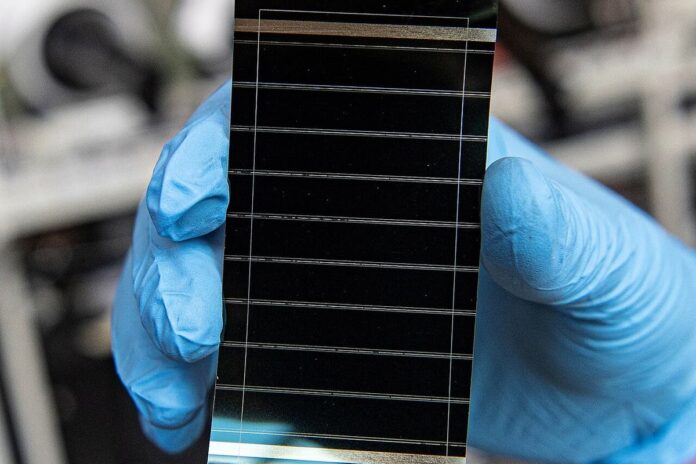Scientists have made a major breakthrough with a new type of solar panel that they claim could supercharge the transition to renewable energy sources. A team from the University of Surrey discovered that a nanoscale ‘ink’ coating could improve stability enough to make next-generation perovskite solar cells suitable for mass production. Perovskite is cheaper and lighter than conventional silicon-based cells, as well as far more efficient, however the emerging technology currently suffers from a drop in efficiency and energy output during the manufacturing process. ‘Performance limits of traditional solar cells are why researchers are switching to examining perovskite as the next-generation solar technology, especially as applications both terrestrial and in space are rapidly growing,’ said Dr Imalka Jayawardena from the University of Surrey’s Advanced Technology Institute (ATI). ‘Our key development in solar panel technology shows a cost-effective approach to scaling of perovskite solar cells, a development which could help countries around the world to reach their net zero targets faster.’ The breakthrough was made when the researchers identified an aluminium oxide that minimises the drop in efficiency during the conditioning of perovskite solar cells. Perovskite has been hailed as a ‘miracle material’ for its potential to transform an array of industries, from ultra high-speed communications to renewable energy. Recent advances have seen it used to create self-healing solar panels that can recover 100 per cent of their efficiency after being damaged by radiation in space, as well as break new efficiency records when combined with silicon to form tandem cells. If the cheap-to-produce perovskite cells can be manufactured at scale while retaining their durability and reliability, then the cost of solar panels would plummet. ‘Solar and wind energy costs are rapidly decreasing based on technology improvements, to the level where worldwide over 80 per cent of all new additional power generation capacity is based on renewables,’ said Ravi Silva, from the ATI, University of Surrey. ‘The levelized cost of solar electricity is now cheaper than most other power-generating sources. With the maturing of perovskite solar modules, the levelized cost of electricity will significantly decrease further, and that is why this is such an exciting area to work.’ The research was detailed in a study , titled ‘Modification of Hydrophobic Self-Assembled Monolayers with Nanoparticles for Improved Wettability and Enhanced Carrier Lifetimes Over Large Areas in Perovskite Solar Cells’, published in the peer-reviewed scientific journal Solar PRL .
Solar panel breakthrough could supercharge ‘miracle material’ production
Sourceindependent.co.uk
RELATED ARTICLES


